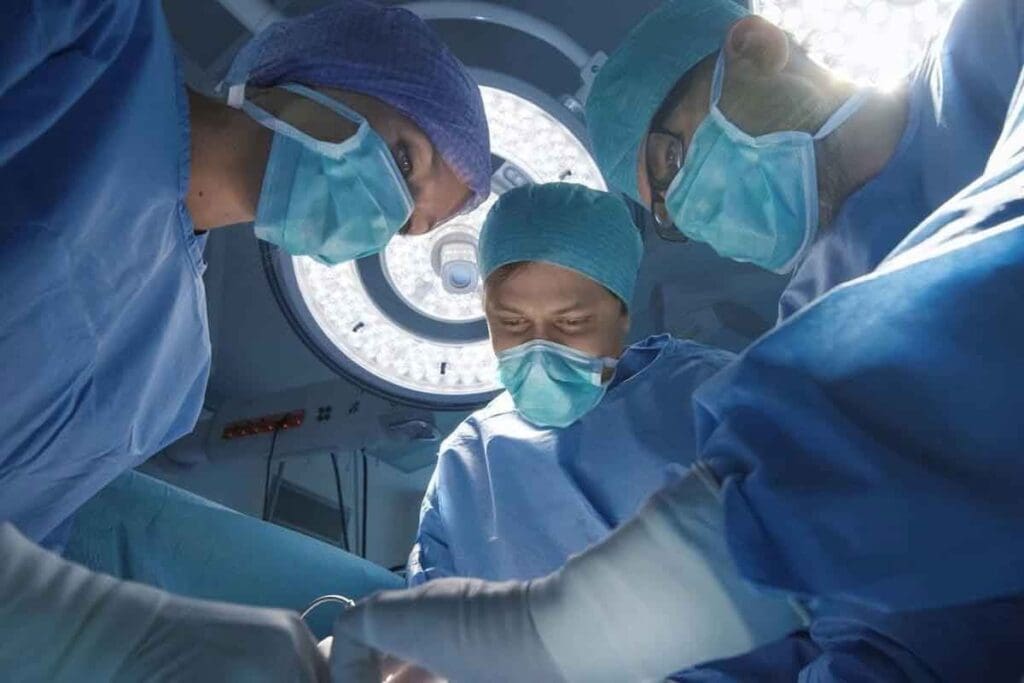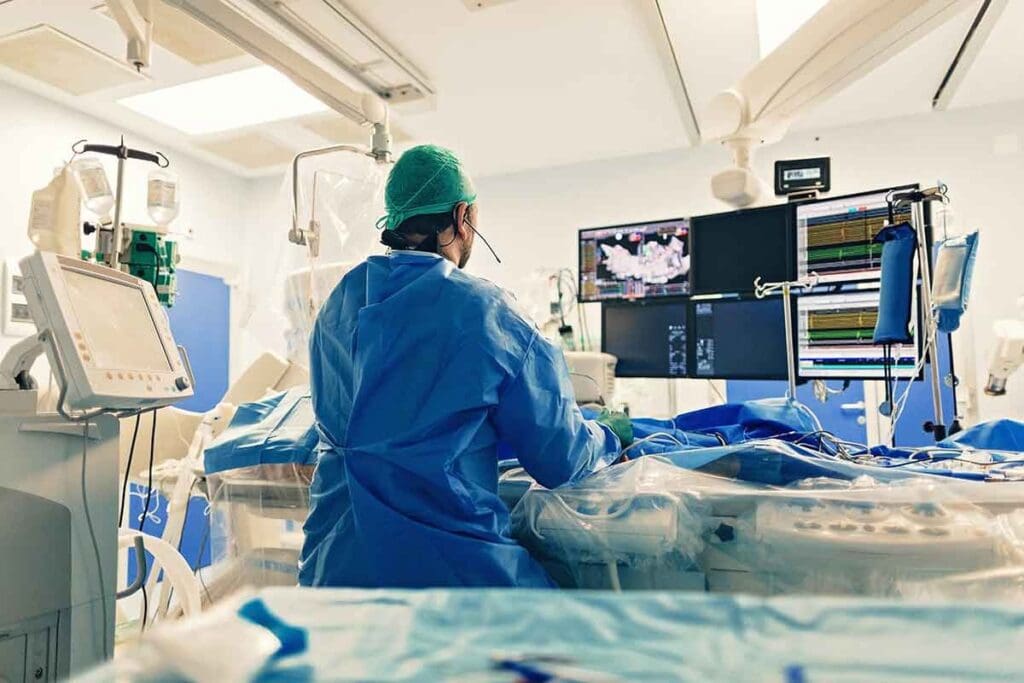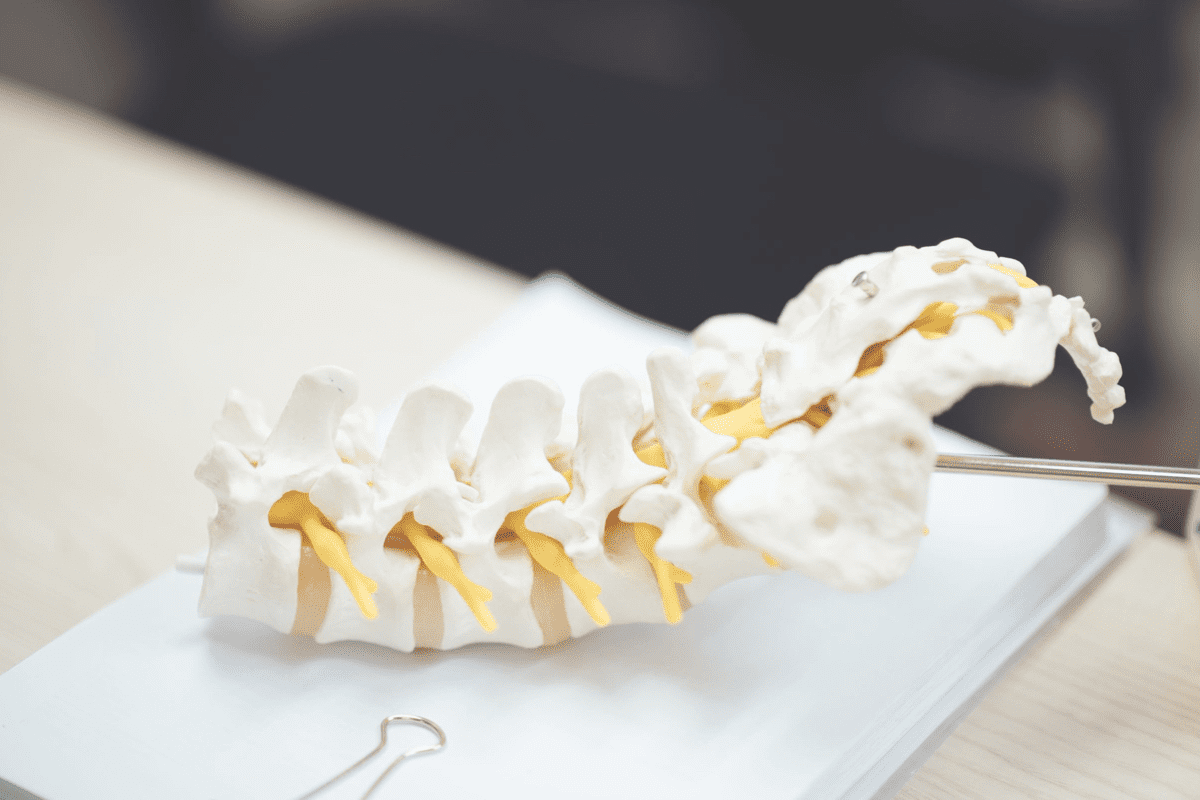Last Updated on November 26, 2025 by Bilal Hasdemir

Learning about coronary artery angiography can ease your mind if you’re facing a heart check-up. At Liv Hospital, we stick to international standards and put our patients first. This means you’ll get a safe, accurate, and comforting experience at every step of your cardiovascular angiography.
We’ll walk you through the angiography procedure for heart. It’s a special imaging test that shows the coronary arteries. It helps find blockages and check your heart health. This procedure is very detailed and shows blood flow through arteries clearly.
Key Takeaways
- Coronary artery angiography is a key tool for checking heart health.
- The procedure is not invasive and finds blockages in the coronary arteries.
- Liv Hospital follows international standards and patient-centered care for a safe experience.
- Knowing the process can give you peace of mind during a heart check-up.
- The angiography procedure for heart helps decide on treatments for heart conditions.
Understanding Coronary Angiography: Definition and Purpose

Coronary angiography is a key medical test. It lets doctors see the heart’s blood vessels. This is important for keeping the heart healthy.
What is Coronary Angiography?
This test uses a special dye and X-rays to see the heart’s arteries. A thin tube is inserted to inject the dye. This makes the arteries show up on the X-rays.
Key aspects of coronary angiography include:
- Minimally invasive procedure
- Use of contrast agent to visualize arteries
- X-ray imaging to capture detailed pictures
Diagnostic Value and Clinical Applications
Coronary angiography is great for spotting heart problems. It shows if the arteries are blocked or narrowed. This helps doctors decide the best treatment.
| Clinical Application | Description |
| Diagnosing Coronary Artery Disease | Identifies blockages or narrowing in the coronary arteries |
| Guiding Interventions | Helps in planning angioplasty, stenting, or other interventions |
| Assessing Cardiac Risk | Evaluates the risk of heart attack or other cardiac events |
When is an Angiogram Recommended?
An angiogram is suggested for those with heart disease symptoms. This includes chest pain or trouble breathing. It’s also for checking if treatments worked.
Knowing about coronary angiography helps patients. It shows how it helps diagnose and treat heart issues. This knowledge helps patients make better choices for their heart health.
Preparation for the Angiography Procedure for Heart

Getting ready for a heart angiography is key. It involves a medical check-up, changing your diet, and making travel plans. Doing these steps well helps the procedure go smoothly and lowers risks.
Pre-procedure Medical Evaluation
First, a detailed health check is done. This looks at your overall health and any risks. It includes checking your medical history, current meds, and allergies. Blood tests also check your kidney function and other health markers.
It’s important to tell your doctor about all meds you’re taking, like blood thinners. Also, share any allergies to contrast dyes or other substances.
Dietary and Medication Restrictions
You’ll need to fast for a few hours before the test, usually after midnight. Some meds, like blood thinners, might need to be stopped or changed. Always follow your doctor’s advice on what to eat and take before the test.
What to Wear and Bring to the Hospital
Wear comfy clothes and avoid jewelry on the day of the test. Make sure someone can drive you home afterward. You might feel a bit out of it.
Mental Preparation for Patients
Getting mentally ready is also important. Ask your doctor any questions you have. Knowing what to expect can help you feel less anxious and more prepared.
| Preparation Step | Description | Importance Level |
| Pre-procedure Medical Evaluation | Comprehensive health assessment | High |
| Dietary Restrictions | Fasting for a specified period | High |
| Medication Adjustment | Adjusting or stopping certain medications | High |
| Comfortable Clothing | Wearing loose, comfortable clothing | Medium |
| Mental Preparation | Understanding the procedure and asking questions | High |
Equipment and Personnel Required for Coronary Angiography
To do coronary angiography, a special lab is needed. It has the latest imaging tech and a team of skilled doctors and radiographers. This team is key to the procedure’s success.
Catheterization Laboratory Setup
The cath lab is where coronary angiography happens. It has a top-notch X-ray system. This system lets doctors see the heart’s arteries in real-time.
Key Components of the Cath Lab:
- X-ray imaging system
- Patient table
- Monitors for vital signs and imaging
- Equipment for administering contrast agents
Medical Team Involved in the Procedure
The medical team is very important for coronary angiography. They include:
| Team Member | Role |
| Cardiologist | Performs the angiography and interprets the results |
| Radiographer | Operates the X-ray imaging system |
| Nurses and Technicians | Assist with patient care and equipment operation |
Imaging and Monitoring Equipment
For coronary angiography, you need the right equipment. This includes:
Imaging Equipment:
- X-ray angiography system
- Contrast agent injector
Monitoring Equipment:
- ECG monitoring
- Blood pressure monitoring
- Oxygen saturation monitoring
Together, the equipment and team make sure the angiography is done right and safely.
Step-by-Step Angiography Procedure for Heart
Let’s explore the angiography procedure for the heart together. You’ll learn what happens during this important test.
Patient Positioning and Preparation
The first step is getting the patient ready. They lie on a special table, usually on their back. The area for the catheter is cleaned and made sterile to avoid infection.
Patient preparation also includes giving them a bit of sedation. This helps them relax during the test.
Local Anesthesia Administration
Next, we give local anesthesia at the catheter site, often in the groin or wrist. We use lidocaine or similar to numb the area. This way, the patient won’t feel pain when we insert the catheter.
Catheter Insertion Techniques
The catheter insertion is a key part of the procedure. We use X-ray guidance to carefully put the catheter into the artery. It’s then guided to the heart’s coronary arteries.
Navigation to the Coronary Arteries
With the catheter in place, we use contrast agents to see the coronary arteries. Injecting dye lets us see the arteries on the X-ray monitor. This helps us spot any blockages or issues.
Getting to the coronary arteries needs precise control and live imaging. This ensures we place the catheter correctly and get an accurate diagnosis.
Cardiac Dye Test: How Contrast Agents Work
Contrast agents are key in cardiac angiography. They make blood vessels stand out, helping doctors spot and fix heart issues.
Types of Contrast Media Used
Cardiac angiography uses different contrast media. The most common are iodine-based and gadolinium-based agents. Iodine-based agents are favored because they block X-rays, making blood vessels show up on X-rays.
We pick these agents to get clear images. This helps doctors make accurate diagnoses.
How Dye Enhances Vessel Visibility
The dye used in the test makes coronary arteries show up on X-rays. This helps find narrowed or blocked arteries. Patients might feel a warm sensation or flushing when the dye is injected. This feeling is usually short-lived and safe.
This clear view is key for spotting coronary artery disease. It helps doctors plan treatments like angioplasty or stenting.
Managing Contrast-Related Reactions
Even though rare, it’s important to know about contrast-related reactions. These can include allergic reactions, kidney issues, and anaphylaxis in extreme cases. We check patients’ health history and watch them closely during and after the test.
Knowing how contrast agents work can make patients feel better during the test. It shows these agents are vital for getting accurate results.
Access Site Options: Femoral vs. Radial Approach
We use two main sites for coronary angiography: the femoral and radial arteries. Each has its own benefits. The choice depends on the patient’s anatomy, the doctor’s preference, and the specific needs of the case.
Femoral Artery Access Technique
The femoral artery access involves a catheter through the groin’s femoral artery. It’s a common method used for many years. It’s often chosen for complex procedures.
Radial Artery Access Procedure
The radial artery access uses the wrist’s radial artery for the catheter. It’s becoming more popular for its benefits in reducing bleeding and improving comfort.
This method lets patients move around sooner after the procedure. A study in the Journal of the American College of Cardiology found, “Radial access cuts down on bleeding and vascular issues.”
Comparing Benefits and Limitations of Each Approach
Both methods have their pros and cons. The femoral approach is familiar for many doctors and easier to reach the coronary arteries. But, it might lead to more bleeding.
- The radial approach lowers bleeding risk and makes patients more comfortable.
- But, it needs more training for doctors and can cause radial artery spasm.
Choosing between femoral and radial access depends on each patient’s needs. Knowing the strengths and weaknesses of each helps us tailor care for each person.
Interventional Procedures During Coronary Angiography
Coronary angiography is more than just a test. It can also lead to immediate treatments for blockages. This makes it a key tool in cardiology, helping doctors diagnose and treat in one go.
Balloon Angioplasty Technique
Balloon angioplasty is a common treatment during coronary angiography. It uses a balloon to widen the artery and improve blood flow. This technique helps restore the artery’s function, often with other treatments.
The process starts with a cardiologist guiding a guidewire through the blockage. Then, a balloon catheter is moved over the guidewire to the blockage site. The balloon is inflated to push the plaque against the artery wall, widening it. After deflation and removal, a stent may be left to keep the artery open.
Coronary Stent Placement Procedure
Stent placement often follows balloon angioplasty. A stent is a small, mesh-like device that keeps the artery open. It’s used to prevent the artery from narrowing again after angioplasty.
There are different stents, like bare-metal and drug-eluting stents. Drug-eluting stents release medication to prevent new tissue growth, reducing restenosis risk. The right stent depends on the patient’s history and the blockage’s characteristics.
Atherectomy and Other Interventions
Atherectomy removes plaque from the artery. It uses devices to clear the blockage, improving blood flow and sometimes avoiding stents.
Other treatments include thrombectomy (clot removal) and specialized devices for complex lesions. The choice depends on the blockage’s specifics and the patient’s health.
Decision-Making Process for Immediate Intervention
Deciding on immediate treatment during coronary angiography involves clinical judgment and angiogram findings. We consider the blockage’s severity, symptoms, and overall health.
| Factor | Considerations | Impact on Decision |
| Blockage Severity | Degree of stenosis, presence of complex lesions | More severe blockages may necessitate immediate intervention |
| Patient Symptoms | Presence of angina, shortness of breath, or other symptoms | Symptomatic patients are more likely to benefit from immediate intervention |
| Overall Health Status | Presence of comorbidities, renal function, etc. | Patients with significant comorbidities may require more cautious decision-making |
By carefully evaluating these factors, we can make informed decisions about the need for and type of interventional procedure to be performed during coronary angiography.
Immediate Post-Procedure Care and Monitoring
Proper care after the procedure is key to a smooth recovery. We move the patient to the recovery area with care. Our focus is on watching for and managing any problems.
Catheter Removal and Access Site Management
We remove the catheter carefully and manage the access site to stop bleeding. We use manual compression or a closure device for this. The choice depends on the site, patient, and doctor’s preference.
Managing the access site well is important to avoid bleeding issues. Our team watches closely for any signs of trouble.
Vital Signs Monitoring Protocol
We keep a close eye on the patient’s vital signs. This includes heart rate, blood pressure, and oxygen levels. This helps us spot any problems early.
| Vital Sign | Normal Range | Action for Abnormal Reading |
| Heart Rate | 60-100 bpm | Notify physician if outside range |
| Blood Pressure | 90-140/60-90 mmHg | Administer medication as prescribed |
| Oxygen Saturation | 95-100% | Provide supplemental oxygen as needed |
Early Complication Detection
Spotting complications early is vital. We watch for heart issues like chest pain or irregular heartbeats. We also check for problems at the access site.
Initial Recovery in the Hospital
In the early recovery phase, patients are closely watched. We make sure they are stable and there are no immediate problems. We give clear instructions to patients and their families about what to expect.
By following a detailed care plan, we can reduce risks and improve outcomes. Our team is dedicated to providing top-notch care during recovery.
Potential Risks and Complications of Coronary Angiography
The coronary angiography procedure is generally safe but comes with some risks. We aim to provide top-notch care. It’s important for patients to know these risks to feel more at ease.
Common Minor Complications
Minor issues can happen during or after the procedure. These might include:
- Bruising or bleeding at the catheter site
- Allergic reactions to the contrast dye
- Temporary kidney function changes, mainly in those with kidney issues
Most minor issues are easy to handle and get better on their own. But, it’s key to follow the post-procedure instructions carefully to lessen these risks.
Serious Complications and Their Management
Though rare, serious problems can occur. These might include:
- Heart attack or stroke during or after the procedure
- Severe allergic reactions to the contrast dye
- Coronary artery dissection or perforation
- Infection at the catheter site
We do everything we can to avoid these serious issues. Our skilled team is ready to act fast if an emergency happens.
Risk Factors for Adverse Events
Some factors can up the risk of problems during or after coronary angiography. These include:
| Risk Factor | Description |
| Age | Older patients may face higher risks |
| Pre-existing medical conditions | Conditions like diabetes, kidney disease, or heart failure can raise risk |
| Previous allergic reactions | Patients with a history of allergic reactions to contrast dye are at higher risk |
Minimizing Complication Risks
To lower the risk of complications, we:
- Do thorough pre-procedure checks
- Use the latest tech and methods
- Make sure our team is well-trained and experienced
- Give clear instructions after the procedure
Knowing the risks and complications of coronary angiography helps patients prepare better. We’re dedicated to providing the best care to reduce these risks and ensure great outcomes.
Recovery Process After Coronary Angiogram Procedure
Patients must follow specific guidelines after a coronary angiogram. This helps avoid complications and ensures the best recovery. Paying close attention to post-procedure care is key.
Hospital Recovery Timeline
Patients stay in the hospital for a few hours after the procedure. Medical staff keep an eye on their vital signs and watch for complications. The exact time in the hospital depends on the patient’s needs and the procedure details.
Discharge Instructions for Patients
Before leaving the hospital, patients get detailed care instructions for home. These discharge instructions include wound care, managing medications, and recognizing signs of complications. It’s important for patients to follow these instructions closely for a smooth recovery.
Activity Restrictions and Gradual Return to Normal Activities
Patients are told to avoid heavy lifting, bending, or strenuous activities for a while. A gradual return to normal activities is advised to allow the body to heal. The exact restrictions and when to start normal activities are discussed during discharge.
Follow-up Care and Appointments
Follow-up care is a critical part of recovery. Patients have scheduled appointments to check on their progress and address any concerns. These visits help catch and manage any issues early on.
In summary, a well-planned recovery after a coronary angiogram is essential for the best results. By following the guidelines from healthcare professionals, patients can reduce risks and ensure a successful recovery.
Conclusion: Advancements in Cardiovascular Angiography
Recent breakthroughs in cardiovascular angiography have made this key procedure safer and more accurate. As we explore new medical technologies, the future of angiography is bright. Ongoing research promises to make it even better.
Improvements in imaging technology have given us clearer views of the heart’s arteries. This helps doctors make better diagnoses and treatment plans. These advances have also cut down recovery times and improved patient results.
The future of angiography will be shaped by new imaging tech and techniques. As these innovations come, we’ll see more tailored and effective care for patients. By keeping up with these advancements, we can offer the best treatments and results for our patients.
FAQ
What is coronary angiography?
Coronary angiography is a way to see the heart’s blood vessels. It uses a special dye to show any blockages. This helps doctors understand heart health.
How is a coronary angiogram done?
To do a coronary angiogram, a thin tube is put into an artery. This tube is guided to the heart’s arteries. Then, dye is injected, and X-rays are taken to see the arteries.
What is the purpose of a cardiac dye test?
A cardiac dye test, or coronary angiography, helps find and treat heart disease. It guides treatment and checks if past treatments worked.
What are the risks associated with coronary angiography?
Risks include bleeding, infection, and allergic reactions. There’s also a chance of damage to the heart or blood vessels.
How do I prepare for an angiography procedure for heart?
Before an angiography, you’ll have a medical check-up. You’ll also need to follow certain diet and medication rules. Wear comfy clothes to the hospital.
What is the difference between femoral and radial artery access?
Femoral access uses the leg artery, while radial uses the wrist. Radial is safer because it has less bleeding risk.
What happens during the recovery process after coronary angiography?
After the test, you’ll be watched closely. Then, you might go home. Follow the doctor’s instructions, rest, and go to follow-up visits.
Can I undergo coronary angiography if I have kidney disease?
People with kidney disease face higher risks. Your doctor will check your risk and take steps to protect you.
How long does it take to recover from a coronary angiogram?
Recovery time varies. Most people can get back to normal in a few days.
What are the benefits of coronary angiography?
It gives doctors accurate info to treat heart disease. This can prevent heart attacks and other serious issues.
Are there any alternative diagnostic tests to coronary angiography?
Yes, tests like CT angiography or stress tests are options. But coronary angiography is the best for diagnosing heart disease.
Reference
Brar, S., & Mehran, R. (2021). Radial versus femoral access for coronary interventions: Meta-analysis of randomized trials. European Heart Journal – Cardiovascular Pharmacotherapy. https://pubmed.ncbi.nlm.nih.gov/33507598/






